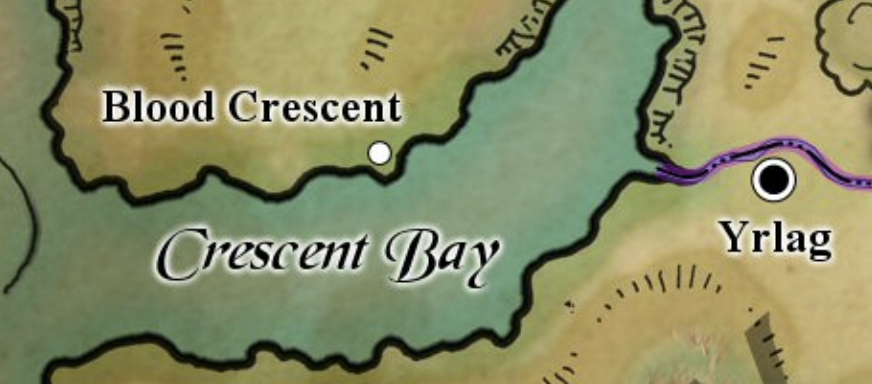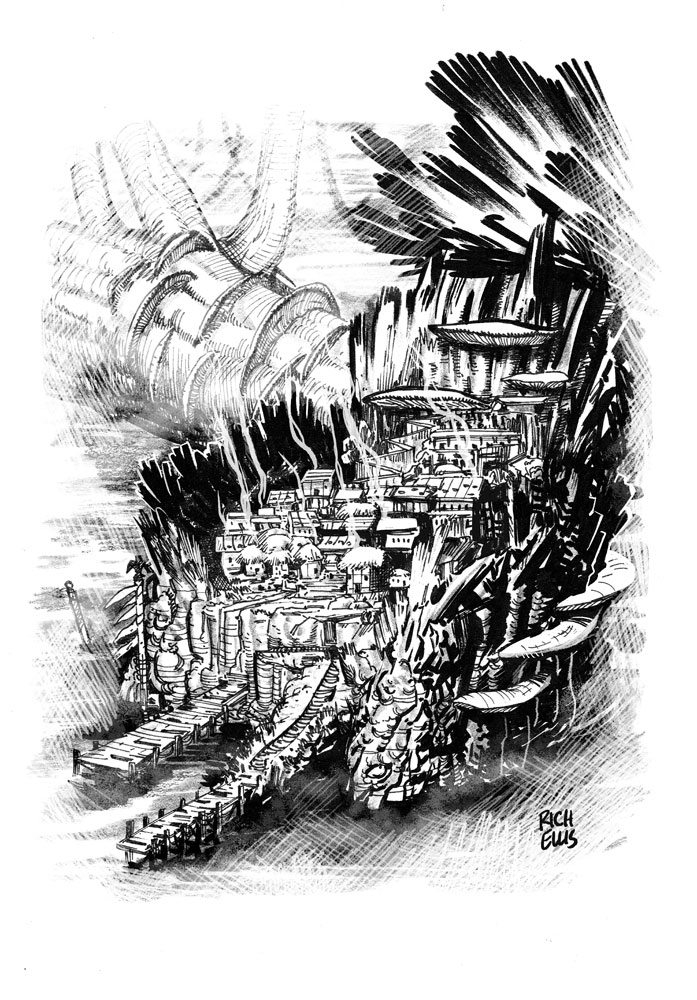
As time permits, I like to answer interesting questions posed by my Patreon supporters. Questions like…

Could you tell us an interesting detail about Yrlag in the Shadow Marches?
Yrlag is one of the largest cities in the Shadow Marches. It’s one of the few safe havens on Crescent Bay, and the most substantial port on the west coast of Khorvaire (which isn’t saying much, but still). Yrlag’s particular claim to fame is its proximity to the Demon Wastes. Due to the diligence of the Ghaash’kala, landing on the coast is far easier than crossing the Labyrinth. With this in mind, Yrlag is to the Demon Wastes as Stormreach is to Xen’drik—a jumping off point and safe haven for scholars, explorers, and opportunists keen to take their chances in the Wastes or to acquire goods recovered from it.
The city is located in a Lamannian manifest zone with The Land Provides property. The land is exceptionally fertile and the river well-stocked with fish—a notably change from Crescent Bay, which is home to many unnatural predators. This is one of the major reasons Yrlag has been able to thrive in such an isolated and inhospitable region. As such, Yrlag has a significant population of farmers, fisherfolk, and hunters who provide for the general needs of the city and travelers.
Yrlag is effectively run by House Tharashk; the Shadow Marches aren’t recognized as a Thronehold Nation, and no one in the region cares about the Korth Edicts. Ships run regularly between Yrlag and the outpost of Blood Crescent… but Blood Crescent is a small fortress that endures constant attacks, and most sages prefer the shelter of Yrlag when conducting long term research. As a result, Yrlag has an unusual number of scholars and luminaries, along with a bookstore and a shop specializing in supplies for calligraphers and cartographers. A number of the Dragonmarked Houses have outposts in Yrlag. There’s a Sivis speaking stone, a Jorasco healer, and even a Gold Dragon Inn. House Lyrandar helps maintain the harbor, but as of yet there’s no airship docking tower and no lightning rail into Yrlag.
There’s far more I could share, but the original question only asked for one detail, and I’ve already gone beyond that!
Doesn’t all travel into the Demon Wastes have to go through the Labyrinth?
The wording in Eberron: Rising From The Last War is unclear, but prior canon has established that it’s possible to travel to the Demon Wastes by sea. The original Eberron Campaign Setting says “Built on the shores of Crescent Bay and regularly supplied by ships from Yrlag, a large town across the bay in the Shadow Marches, Blood Crescent serves as House Tharashk’s long dreamed-of foothold in the Demon Wastes”—it would be hard to regularly supply the outpost if every ship that arrived couldn’t leave. The general intent is that FIENDS can’t leave except through the Labyrinth; think of it like an invisible fiend fence with only one gap in it. With that said, it’s not supposed to be EASY to travel to the Wastes by sea; if it was, people would have done it long ago and we’ve have more and larger outposts. The coastline is extremely hostile, with a combination of foul weather, unnatural sealife, and a maze of demonglass spires that can tear a ship apart. Reaching Blood Crescent requires the vessel to follow a very specific path. Tharashk spent a great deal of resources to chart that path, and they are holding it as a secret of the house.
So it’s easy to reach the Demon Wastes by sea, but MOST of the time, those who try will end up shipwrecked… which is in fact what happened to the ancestors of the Carrion Tribes. Meanwhile, the Carrion Tribes themselves don’t have the sophistication or resources to build ships, which is why when they try to leave, they go through the Labyrinth.
In the Player’s Guide to Eberron we learned that Lhazaar Prince Kolberkon of the Direshark Principality is a changeling. Do you think Kolberkon’s changeling nature is known or something he keeps hidden behind personas?
In my campaign, Prince Kolberkin is a changeling foundling, as described in this article. He was raised by his mother and has a human persona that he considers to be his true face; he doesn’t identify as a changeling, have any familiarity with tribal changeling customs, or have any sympathy or affection for the changelings of the Gray Tide. He makes no effort to hide his ability to shapechange; he used it very effectively in his rise to power, and he uses it to keep his enemies and potential traitors on their toes, but he doesn’t feel any bond to other changelings or consider his changeling face to be his true identity.
This ties to the point that in Eberron, culture is often more significant than species. He’s a Lhazaar pirate who happens to be a changeling; but he doesn’t care about the Children, the Traveler, or any of that. As the Prince of the Diresharks, he takes pride in being a PREDATOR, and uses his shapeshifting as a tool to help him overcome his prey. He’s extremely skilled at shifting shape in combat in ways that may give him momentary advantage—not fooling an enemy in the long term, but throwing them off their guard.
With that said, while Kolberkon considers his first human face to be his core identity, he also will shift that to fit the situation; when negotiating with Lyrandar, for example, he may assume a half-elf version of his human form, sort of like dressing up for a meeting. So again, he doesn’t hide the fact he’s a shapechanger; he celebrates it. As such, he uses this gift in obvious ways. When he becomes a Khoravar to meet with Lyrandar, he’s not trying to FOOL them; it’s a Khoravar version of his normal appearance, just done as a “Hey, I recognize you’re Khoravar, and you know, I could be too.”
So in short, he often uses casual shapeshifting in ways that he thinks may give him a psychological advantage. It’s known that he CAN impersonate other people—potential traitors KNOW that any of their conspirators could be Kolberkin playing a game with them—but he more also uses it in obvious, social ways.
The most famous city in Khorvaire—Sharn—is built around a manifest zone. Are most cities built up around manifest zones, or is it the rarity?
Manifest zones are much like natural resources in our world. Most manifest zones provide an ongoing, reliable effect. Some are dangerous, and such regions tend to be shunned. Others are beneficial, and these areas often become hubs for civilization, just as rich deposits of natural resources often draw communities in our world. Yrlag is an example of this: if people in an inhospitable region find a manifest zone that enhances the quality of the land and of life, why wouldn’t they settle there and make use of it?
The short form is that communities that thrive usually do so for a reason. Rich natural resources. Strategic value. Fertile land. In Eberron, useful manifest zones are one more item on that checklist. Not every city is in a manifest zone; but every city will usually have SOME reason to be where it is, and in Eberron, manifest zones are an important part of that equation. Also keep in mind that manifest zones vary dramatically in size and power. The Lamannian zone that contains Yrlag is a wide zone that blankets the city, as does the Syranian manifest zone in Sharn. But you can also find manifest zones that cover the space of a single building, or even a single room. A town might spring up around a Jorasco healing house built in an Irian manifest zone… but the zone is small enough, that only those in the healing house benefit from its power.
So most major cities likely have a manifest zone SOMEWHERE in the city, though not all. In some cases this has been called out, as with Sharn or Atur. They aren’t alone, but I don’t currently have time to make a thorough list of zones that can be found in other major cities. If there’s interest on Patreon, this could be the subject of a future article.
Can Mabar consume fragments of Irian?
Mabar, also known as the Endless Night, consumes fragments of other planes. On the other end of the spectrum, Irian creates new seeds of light that fill the voids left behind by Mabar. As a general rule, Mabar doesn’t consume pieces of Irian itself. The two are two sides of a single coin, reflecting creation and destruction; they tell their story by interacting with other planes, and usually don’t target one another directly. With that said, it’s POSSIBLE that Mabar could consume a piece of Irian… and if it did, Irian would in turn regrow that missing piece.
That’s all for now! Thanks to my Patreon supporters for providing interesting questions and for making these articles possible.

